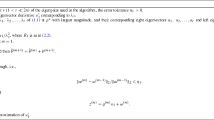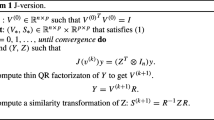Abstract
The values of all the components of the magnetic induction vector and its first-order spatial derivatives are determined from the spatial distribution of the magnetic field parameter values at each point of the observation plane. The inverse problem is solved using the analytic eigenvector method. The execution of the proposed algorithm was simulated using real data of magnetometric studies in the geomagnetic field.
Similar content being viewed by others
References
M. N. Nabighian, V. J. S. Grauch, R. O. Hansen, T. R. LaFehr, Y. Li, J. W. Peirce, J. D. Phillips, and M. E. Ruder, “The historical development of the magnetic method in exploration,” Geophysics, Vol. 70, No. 6, 33ND–61ND (2005).
Yu. I. Blokh, Interpretation of Gravitational and Magnetic Anomalies [in Russian], MGGA, Moscow, (2009).
W. Baranov, Potential Fields and Their Transformations in Applied Geophysics [Russian translation], Nedra, Moscow (1980).
M. A. Primin, V. I. Goumenyuk-Sychevsky, and I. V. Nedayvoda, Methods and Algorithms for Localization of Magnetic Field Source [in Russian], Naukova Dumka, Kyiv (1992).
M. Primin and I. Nedayvoda, “Inverse problem solution algorithms in magnetocardiography: New analytical approach and some results,” International Journal of Applied Electromagnetics and Mechanics, Vol. 29, No. 2, 65–81 (2009).
M. A. Primin and I. V. Nedayvoda, “A method and an algorithm to reconstruct the spatial structure of current density vectors in magnetocardiography,” Cybernetics and Systems Analysis, Vol. 53, No. 3, 485–494 (2017). https://doi.org/10.1007/s10559-017-9950-6.
L. B. Pedersen and T. M. Rasmussen, “The gradient tensor of potential field anomalies: Some implications on data collection and data processing of maps,” Geophysics, Vol. 55, No. 12, 1558–1566 (1990).
A. Chwala, R. Stolz, V. Zakosarenko, L. Fritzsch, M. Schulz, A. Rompel, L. Polome, M. Meyer, and H. G. Meyer, “Full tensor SQUID gradiometer for airborne exploration,” in: 22nd International Geophysical Conference and Exhibition, Brisbane, Australia (2012), pp. 1–4.
P. Schmidt, D. Clark, K. Leslie, M. Bick, D. Tilbrook, and C. Foley, “GETMAG — a SQUID magnetic tensor gradiometer for mineral and oil exploration,” Exploration Geophysics, Vol. 35, No. 4, 297–305 (2004).
T. J. Gamey, Development and Evaluation of an Airborne Superconducting Quantum Interference Device-Based Magnetic Gradiometer Tensor System for Detection, Characterization and Mapping of Unexploded Ordnance: SERDP Project MM-1316 (2008).
W. M. Wynn, C. P. Frahm, P. J. Carroll, R. H. Clark, J. Wellhoner, and M. J. Wynn, “Advanced superconducting gradiometer/magnetometer arrays and a novel signal processing technique,” IEEE Trans. Mag., Vol. 11, Iss. 2, 701–707 (1975).
Yu. V. Maslennikov, M. A. Primin, V. Yu. Slobodtchikov, I. V. Nedayvoda, V. A. Krymov, V. V. Khanin, G. G. Ivanov, N. A. Bulanova, S. Yu. Kuznetsova, and V. N. Gunaeva, “SQUID-based magnetometric systems for cardiac diagnostics,” Biomedical Engineering, Vol. 51, No. 3, 153–156 (2017).
Author information
Authors and Affiliations
Corresponding author
Additional information
Translated from Kibernetika i Sistemnyi Analiz, No. 2, March–April, 2019, pp. 188–200.
Rights and permissions
About this article
Cite this article
Primin, M.A., Nedayvoda, I.V. Method and Algorithm for Obtaining Elements of the Tensor of Spatial Derivatives of the Magnetic Induction Vector in the Problem of Searching for Magnetic Anomalies. Cybern Syst Anal 55, 336–346 (2019). https://doi.org/10.1007/s10559-019-00139-2
Received:
Published:
Issue Date:
DOI: https://doi.org/10.1007/s10559-019-00139-2




